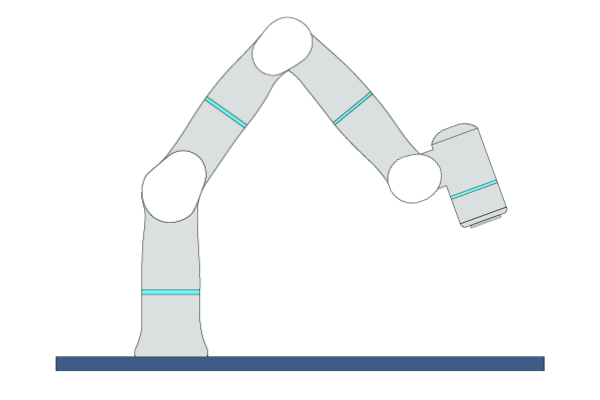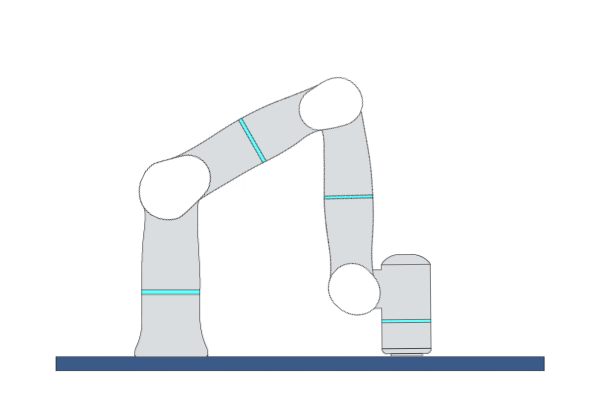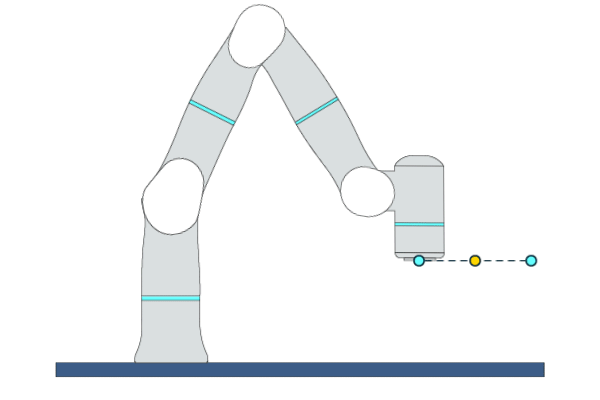Advanced Force Control
ContactAlign

Primitive Description and Usage
Description: This primitive maintains force control and moves the robot in a predefined direction with a set force until it contacts with the environment while adjusting the robot’s position and orientation to make it compliant and align with the environment.
Example Usage: Use this primitive when the robot’s final target pose is not a perfectly predefined pose. For example, when grasping an object whose position is uncertain, use this primitive so that the robot can first use the contact information to understand the spatial relationship between the target object and itself, and then perform grasping.
Primitive Input Parameters
Input Parameter |
Description |
Type |
Unit |
Default Value & Range |
|---|---|---|---|---|
contactAxis |
Contact (force control) direction in TCP coordinate system, which should be along one of TCP’s principal axes [X, Y, Z] |
VEC_3d |
none |
0 0 1 ∈ [-1 -1 -1 … 1 1 1] |
contactVel |
TCP linear velocity along the contact axis to the contact surface |
DOUBLE |
m/s |
0.01 ∈ [0.001 … 0.03] |
contactForce |
Target force along the contact axis |
DOUBLE |
N |
5 ∈ [5 … 30] |
alignAxis |
Alignment motion direction in TCP coordinate system. The robot performs alignment motion along the axis whose value is set to 1. |
VEC_6i |
none |
0 0 0 0 0 0 ∈ [0 0 0 0 0 0 … 1 1 1 1 1 1] |
alignVelScale |
Velocity scale of alignment motion. Higher alignment velocity results in faster but less stable motion. |
DOUBLE |
none |
0.2 ∈ [0.01 … 1.0] |
deadbandScale |
Deadband scale of the TCP force/moment. Robot will keep its stiffness until the TCP force/moment exceeds this deadband. Lower deadband results in more compliant but less stable motion. |
DOUBLE |
none |
0.2 ∈ [0.01 … 1.0] |
Primitive State Parameters
State Parameter |
Description |
Type |
Unit |
|---|---|---|---|
terminated |
The termination flag of the primitive. It is set to true if the primitive is terminated. |
BOOL |
none |
timePeriod |
The time spent on running the current primitive. |
DOUBLE |
s |
alignContacted |
Flag to indicate that the alignment motion has been finished |
BOOL |
none |
forwardDis |
Forward distance from the start position to engaging the contact |
DOUBLE |
m |
Primitive Output Parameters
Output Parameter |
Description |
Type |
Unit |
|---|---|---|---|
tcpPoseOut |
The TCP pose when the primitive is terminated. It is represented in the world coordinate system. |
COORD |
m-deg |
Default Transition Condition
State Parameter |
Condition |
Value |
|---|---|---|
alignContacted |
= |
1 |

ForceHybrid

Primitive Description and Usage
Description: This primitive controls the robot TCP to move linearly through waypoints to the target pose in hybrid motion/force control mode with force exerted in the force control direction.
Example Usage: Use this primitive for better hybrid motion/force control performance when the robot needs to exert forces externally while running a trajectory.
Primitive Input Parameters
Input Parameter |
Description |
Type |
Unit |
Default Value & Range |
|---|---|---|---|---|
target* |
Target TCP pose |
COORD |
m-deg |
[traj_start* world*] |
waypoint |
Waypoint pose |
ARRAY_COORD |
m-deg |
[traj_start* traj_goal* traj_prev* world*] |
wrench |
Force and torque applied on the waypoint |
ARRAY_VEC_6d |
N |
|
vel |
TCP linear velocity |
DOUBLE |
m/s |
0.25 ∈ [0.001 … 2.2] |
acc |
TCP linear acceleration |
DOUBLE |
m/s^2 |
1.5 ∈ [0.1 … 3.0] |
zoneRadius |
Blending zone radius while TCP approximates the waypoints |
TYPE |
none |
Z50 ∈ [ZFine Z1 Z5 Z10 Z15 Z20 Z30 Z40 Z50 Z60 Z80 Z100 Z150 Z200] |
targetTolerLevel |
Tolerance level to determine if the robot has reached the target. 1 means to check with the smallest tolerance, 0 means no tolerance check. |
INT |
none |
0 ∈ [0 … 10] |
forceCoord |
Reference coordinate system for force control direction |
COORD |
m-deg |
0 0 0 0 0 0 TCP ONLINE ∈ [world* tcp_start* tcp*] |
forceAxis* |
Activated axes of force control coordinate to apply force or torque |
VEC_6i |
none |
0 0 1 0 0 0 ∈ [0 0 0 0 0 0 … 1 1 1 1 1 1] |
targetWrench* |
Force and torque applied at target pose |
VEC_6d |
N |
0.0 0.0 -5.0 0.0 0.0 0.0 |
angVel |
TCP angular velocity |
DOUBLE |
deg/s |
150.0 ∈ [10.0 … 500.0] |
enableFixRefJntPos |
Flag to indicate if fixed reference joint position is enabled. If this parameter is set to TRUE, the primitive will use the value of parameter [refJntPos] as the fixed joint reference position instead of the reference joint position of each waypoint during execution. |
BOOL |
none |
0 ∈ [0 / 1] |
refJntPos |
Reference target joint positions. When the robot moves in Cartesian space, each joint will move as close as possible toward the reference position. |
JPOS |
deg |
0.0 -40.0 0.0 90.0 0.0 40.0 0.0 0.0 0.0 0.0 0.0 0.0 0.0 |
jerk |
TCP linear jerk |
DOUBLE |
m/s^3 |
200.0 ∈ [50.0 … 500.0] |
configOptObj |
Weights of three configuration optimization objectives during robot motion, which respectively are to make the robot easier to translate in Cartesian space, easier to rotate in Cartesian space, and closer to the reference joint position. |
VEC_3d |
none |
0.0 0.0 0.5 ∈ [0.0 0.0 0.1 … 1.0 1.0 1.0] |
stiffScale |
Robot stiffness scale during motion. The lower the stiffness scale, the more compliant the motion. |
VEC_6d |
none |
1.0 1.0 1.0 1.0 1.0 1.0 ∈ [0.01 0.01 0.01 0.01 0.01 0.01 … 1.0 1.0 1.0 1.0 1.0 1.0] |
enableMaxWrench |
Flag to indicate if maximum contact wrench is enabled in each Cartesian direction: X, Y, Z, Rx, Ry, Rz |
VEC_6i |
none |
0 0 0 0 0 0 ∈ [0 0 0 0 0 0 … 1 1 1 1 1 1] |
maxContactWrench |
Maximum contact wrench allowed for static collision along Fx, Fy, Fz, Mx, My, Mz |
VEC_6d |
N |
150.0 150.0 150.0 40.0 40.0 40.0 ∈ [5.0 5.0 5.0 1.0 1.0 1.0 … 150.0 150.0 150.0 40.0 40.0 40.0] |
maxVelForceDir |
Maximum movement velocity along force control direction |
VEC_3d |
m/s |
2.0 2.0 2.0 ∈ [0.005 0.005 0.005 … 2.0 2.0 2.0] |
*Parameters marked with an asterisk must be assigned a value prior to executing the primitive.
*Coordinate System Definition
Coordinate |
Definition |
Value Format |
|---|---|---|
world |
WORLD coordinate system, which is a fixed Cartesian coordinate system located at the center of the robot base |
X Y Z Rx Ry Rz WORLD WORLD_ORIGIN |
work |
WORK coordinate system, which defines the position of the workpiece relative to the WORLD coordinate system |
X Y Z Rx Ry Rz WORK WorkCoordName |
tcp |
TCP coordinate system, which is located at the Tool Center Point relative to the center of robot flange |
X Y Z Rx Ry Rz TCP ONLINE |
tcp_start |
The fixed coordinate system which is located at the initial TCP pose of the primitive |
X Y Z Rx Ry Rz TCP START |
traj_start |
The offset of a waypoint relative to the initial TCP pose in the TCP coordinate system |
X Y Z Rx Ry Rz TRAJ START |
traj_goal |
The offset of a waypoint relative to the target TCP pose in the TCP coordinate system |
X Y Z Rx Ry Rz TRAJ GOAL |
traj_prev |
The offset of a waypoint relative to the previous waypoint in the TCP coordinate system |
X Y Z Rx Ry Rz TRAJ PREVIOUSWAYPOINT |
You can use the simplified value format above to describe a waypoint, while the complete description of a Cartesian waypoint is: X Y Z Rx Ry Rz ReferenceCoordinate A1 A2 A3 A4 A5 A6 A7 E1 E2 E3 E4 E5 E6. A1 to A7 are the preferred joint positions of the robot; X1 to X6 are the target positions of external axes. The additional data can be added if necessary.
Add “:” to separate the waypoints. For example: 0.2 0 0.3 0 180 0 WORLD WORLD_ORIGIN : 0.2 0.1 0.3 0 180 0 WORLD WORLD_ORIGIN.
*Robot Joint Position Description
The complete description of a joint waypoint (JPOS) is: A1 A2 A3 A4 A5 A6 A7 E1 E2 E3 E4 E5 E6. A1 to A7 are the joint positions of the robot; X1 to X6 are the positions of external axes. You can only set the robot joint positions if external axes do not exist. For example: {jnt_def_1}.
Add “:” to separate the waypoints. For example: {jnt_def_2}.
Primitive State Parameters
State Parameter |
Description |
Type |
Unit |
|---|---|---|---|
terminated |
The termination flag of the primitive. It is set to true if the primitive is terminated. |
BOOL |
none |
timePeriod |
The time spent on running the current primitive. |
DOUBLE |
s |
reachedTarget |
Flag to indicate if the robot has reached the target |
BOOL |
none |
waypointIndex |
Index of the current waypoint the robot just passed. 0 means the initial pose. |
INT |
none |
Primitive Output Parameters
Output Parameter |
Description |
Type |
Unit |
|---|---|---|---|
tcpPoseOut |
The TCP pose when the primitive is terminated. It is represented in the world coordinate system. |
COORD |
m-deg |
Default Transition Condition
State Parameter |
Condition |
Value |
|---|---|---|
reachedTarget |
= |
1 |

ForceComp

Primitive Description and Usage
Description: This primitive controls the robot TCP to move compliantly through waypoints to the target pose. You can set appropriate values for parameters [stiffScale] and [maxContactWrench] to obtain desired compliant motion behaviors.
Example Usage: Use this primitive when the robot has a chance to collide with an unknown environment during Cartesian movement or when you want to compliantly interact with the robot during movement.
Primitive Input Parameters
Input Parameter |
Description |
Type |
Unit |
Default Value & Range |
|---|---|---|---|---|
target* |
Target TCP pose |
COORD |
m-deg |
[traj_start* world*] |
waypoints |
Waypoints between initial and target poses |
ARRAY_COORD |
m-deg |
[traj_start* traj_goal* traj_prev* world*] |
vel |
TCP linear velocity |
DOUBLE |
m/s |
0.25 ∈ [0.001 … 2.2] |
zoneRadius |
Blending zone radius while TCP approximates the waypoints |
TYPE |
none |
Z50 ∈ [ZFine Z1 Z5 Z10 Z15 Z20 Z30 Z40 Z50 Z60 Z80 Z100 Z150 Z200] |
targetTolerLevel |
Tolerance level to determine if the robot has reached the target. 1 means to check with the smallest tolerance, 0 means no tolerance check. |
INT |
none |
0 ∈ [0 … 10] |
compCoord |
Reference coordinate system for the compliant motion |
COORD |
m-deg |
0 0 0 0 0 0 WORLD WORLD_ORIGIN ∈ [world* tcp_start* tcp*] |
stiffScale |
Robot stiffness scale during motion. The lower the stiffness scale, the more compliant the motion. |
VEC_6d |
none |
1.0 1.0 1.0 1.0 1.0 1.0 ∈ [0.01 0.01 0.01 0.01 0.01 0.01 … 1.0 1.0 1.0 1.0 1.0 1.0] |
enableMaxWrench |
Flag to indicate if maximum contact wrench is enabled in each Cartesian direction: X, Y, Z, Rx, Ry, Rz |
VEC_6i |
none |
0 0 0 0 0 0 ∈ [0 0 0 0 0 0 … 1 1 1 1 1 1] |
maxContactWrench |
Maximum contact wrench allowed for static collision along Fx, Fy, Fz, Mx, My, Mz |
VEC_6d |
N |
150.0 150.0 150.0 40.0 40.0 40.0 ∈ [5.0 5.0 5.0 1.0 1.0 1.0 … 150.0 150.0 150.0 40.0 40.0 40.0] |
acc |
TCP linear acceleration |
DOUBLE |
m/s^2 |
1.5 ∈ [0.1 … 3.0] |
angVel |
TCP angular velocity |
DOUBLE |
deg/s |
150.0 ∈ [10.0 … 500.0] |
enableFixRefJntPos |
Flag to indicate if fixed reference joint position is enabled. If this parameter is set to TRUE, the primitive will use the value of parameter [refJntPos] as the fixed joint reference position instead of the reference joint position of each waypoint during execution. |
BOOL |
none |
0 ∈ [0 / 1] |
refJntPos |
Reference target joint positions. When the robot moves in Cartesian space, each joint will move as close as possible toward the reference position. |
JPOS |
deg |
0.0 -40.0 0.0 90.0 0.0 40.0 0.0 0.0 0.0 0.0 0.0 0.0 0.0 |
jerk |
TCP linear jerk |
DOUBLE |
m/s^3 |
200.0 ∈ [50.0 … 500.0] |
configOptObj |
Weights of three configuration optimization objectives during robot motion, which respectively are to make the robot easier to translate in Cartesian space, easier to rotate in Cartesian space, and closer to the reference joint position. |
VEC_3d |
none |
0.0 0.0 0.5 ∈ [0.0 0.0 0.1 … 1.0 1.0 1.0] |
*Parameters marked with an asterisk must be assigned a value prior to executing the primitive.
*Coordinate System Definition
Coordinate |
Definition |
Value Format |
|---|---|---|
world |
WORLD coordinate system, which is a fixed Cartesian coordinate system located at the center of the robot base |
X Y Z Rx Ry Rz WORLD WORLD_ORIGIN |
work |
WORK coordinate system, which defines the position of the workpiece relative to the WORLD coordinate system |
X Y Z Rx Ry Rz WORK WorkCoordName |
tcp |
TCP coordinate system, which is located at the Tool Center Point relative to the center of robot flange |
X Y Z Rx Ry Rz TCP ONLINE |
tcp_start |
The fixed coordinate system which is located at the initial TCP pose of the primitive |
X Y Z Rx Ry Rz TCP START |
traj_start |
The offset of a waypoint relative to the initial TCP pose in the TCP coordinate system |
X Y Z Rx Ry Rz TRAJ START |
traj_goal |
The offset of a waypoint relative to the target TCP pose in the TCP coordinate system |
X Y Z Rx Ry Rz TRAJ GOAL |
traj_prev |
The offset of a waypoint relative to the previous waypoint in the TCP coordinate system |
X Y Z Rx Ry Rz TRAJ PREVIOUSWAYPOINT |
You can use the simplified value format above to describe a waypoint, while the complete description of a Cartesian waypoint is: X Y Z Rx Ry Rz ReferenceCoordinate A1 A2 A3 A4 A5 A6 A7 E1 E2 E3 E4 E5 E6. A1 to A7 are the preferred joint positions of the robot; X1 to X6 are the target positions of external axes. The additional data can be added if necessary.
Add “:” to separate the waypoints. For example: 0.2 0 0.3 0 180 0 WORLD WORLD_ORIGIN : 0.2 0.1 0.3 0 180 0 WORLD WORLD_ORIGIN.
*Robot Joint Position Description
The complete description of a joint waypoint (JPOS) is: A1 A2 A3 A4 A5 A6 A7 E1 E2 E3 E4 E5 E6. A1 to A7 are the joint positions of the robot; X1 to X6 are the positions of external axes. You can only set the robot joint positions if external axes do not exist. For example: {jnt_def_1}.
Add “:” to separate the waypoints. For example: {jnt_def_2}.
Primitive State Parameters
State Parameter |
Description |
Type |
Unit |
|---|---|---|---|
terminated |
The termination flag of the primitive. It is set to true if the primitive is terminated. |
BOOL |
none |
timePeriod |
The time spent on running the current primitive. |
DOUBLE |
s |
reachedTarget |
Flag to indicate if the robot has reached the target |
BOOL |
none |
waypointIndex |
Index of the current waypoint the robot just passed. 0 means the initial pose. |
INT |
none |
Primitive Output Parameters
Output Parameter |
Description |
Type |
Unit |
|---|---|---|---|
tcpPoseOut |
The TCP pose when the primitive is terminated. It is represented in the world coordinate system. |
COORD |
m-deg |
Default Transition Condition
State Parameter |
Condition |
Value |
|---|---|---|
reachedTarget |
= |
1 |
